A Correlational Analysis of Shuttlecock Speed Kinematic Determinants in the Badminton Jump Smash
Abstract
:Featured Application
Abstract
1. Introduction
2. Materials and Methods
2.1. Participants
2.2. Data Collection
2.3. Data Reduction
2.4. Statistical Analysis
3. Results
4. Discussion
5. Conclusions
Author Contributions
Funding
Conflicts of Interest
References
- Tong, Y.-M.; Hong, Y. The playing pattern of world’s top single badminton players. In Proceedings of the 18th International Symposium on Biomechanics in Sports, Hong Kong, China, 25–30 June 2000; pp. 825–830. [Google Scholar]
- Ramasamy, Y.; Osman, J.; Sundar, V.; Joseph, S. Ground reaction force and kinematics of forehand jumping smash among elite Malaysian badminton players. In Proceedings of the 37th International Society of Biomechanics in Sport Conference, Oxford, OH, USA, 21–25 July 2019. [Google Scholar]
- Guinness World Records, Fastest Badminton Hit in Competition (Male). Available online: https://www.guinnessworldrecords.com/world-records/fastest-badminton-hit-in-competition-(male)/ (accessed on 19 June 2019).
- Rambely, A.S.; Osman, N.A.A.; Usman, J.; Abas, W.A.B.W. The contribution of upper limb joints in the development of racket velocity in the badminton smash. In Proceedings of the 23rd International Symposium on Biomechanics in Sports, Beijing, China, 22–27 August 2005. [Google Scholar]
- Rasmussen, J.; Kwan, M.; Andersen, M.S.; De Zee, M. Analysis of segment energy transfer using musculoskeletal models in a high speed badminton stroke. In Proceedings of the 9th International Symposium on Computer Methods in Biomechanics and Biomedical Engineering, Valencia, Spain, 24–27 February 2010. [Google Scholar]
- Liu, X.; Kim, W.; Tan, J. An Analysis of the Biomechanics of Arm Movement during a Badminton Smash. Nanyang Technology University: Singapore, 2002. [Google Scholar]
- Sprigings, E.; Marshall, R.; Elliott, B.; Jennings, L. A three-dimensional kinematic method for determining the effectiveness of arm segment rotations in producing racquet-head speed. J. Biomech. 1994, 27, 245–254. [Google Scholar] [CrossRef]
- Abdel-Aziz, Y.I.; Karara, H.M. Direct linear transformation from comparator coordinates into object coordinates in close-range photogrammetry. In Proceedings of the ASP Symposium on Close-Range Photogrammetry, Urbana, IL, USA, 26–29 January 1971. [Google Scholar]
- Teu, K.K.; Kim, W.; Tan, J.; Fuss, F.K. Using dual Euler angles for the analysis of arm movement during the badminton smash. Sports Eng. 2005, 8, 171–178. [Google Scholar] [CrossRef]
- McErlain-Naylor, S.; King, M.; Pain, M.T.G. Determinants of countermovement jump performance: A kinetic and kinematic analysis. J. Sports Sci. 2014, 32, 1805–1812. [Google Scholar] [CrossRef] [PubMed] [Green Version]
- Worthington, P.; King, M.; Ranson, C. The influence of cricket fast bowlers’ front leg technique on peak ground reaction forces. J. Sports Sci. 2013, 31, 434–441. [Google Scholar] [CrossRef] [PubMed] [Green Version]
- Winter, D.A. Biomechanics and Motor Control of Human Movement, 4th ed.; Wiley: New York, NY, USA, 2009; pp. 70–73. [Google Scholar]
- Wu, G.; Van Der Helm, F.C.T.; Veeger, H.E.J.; Makhsous, M.; Van Roy, P.; Anglin, C.; Nagels, J.; Karduna, A.R.; McQuade, K.; Wang, X.; et al. ISM recommendation on definitions of joint coordinate systems of various joints for the reporting of human joint motion-Part II: Shoulder, elbow, wrist and hand. J. Biomech. 2005, 36, 981–992. [Google Scholar] [CrossRef]
- Zhang, Z.; Li, S.; Wan, B.; Visentin, P.; Jiang, Q.; Dyck, M.; Shan, G. The influence of X-factor (trunk rotation) and experience on the quality of the badminton forehand smash. J. Hum. Kinet. 2016, 53, 9–22. [Google Scholar] [CrossRef] [Green Version]
- De Leva, P. Adjustments to Zatsiorsky-Seluyanov’s segment inertia parameters. J. Biomech. 1996, 29, 1223–1230. [Google Scholar] [CrossRef]
- Peploe, C.; McErlain-Naylor, S.A.; Harland, A.R.; Yeadon, M.R.; King, M.A. A curve fitting methodology to determine impact location, timing, and instantaneous post-impact ball velocity in cricket batting. J. Sports Eng. Technol. 2018, 232, 185–196. [Google Scholar] [CrossRef] [Green Version]
- Cohen, C.; Texier, B.D.; Quéré, D.; Clanet, C. The physics of badminton. New J. Phys. 2015, 17, 063001. [Google Scholar] [CrossRef]
- Brahms, B.V. Badminton Handbook: Training, Tactics, Competition, 2nd ed.; Meyer & Meyer Sport: Maidenhead, UK, 2014. [Google Scholar]
- Martin, C.; Kulpa, R.; Delamarche, P.; Bideau, B. Professional tennis players; serve: Correlation between segmental angular momentums and ball velocity. Sports Biomech. 2012, 12, 2–14. [Google Scholar] [CrossRef]
- Hinkle, D.; Wiersma, W.; Jurs, S.G. Applied Statistics for the Behavioural Sciences, 5th ed.; Houghton Miffin: Boston, MA, USA, 2003. [Google Scholar]
- Bowerman, B.L.; O’Connell, R.T. Linear Statistical Models: An Applied Approach; Duxbery Press: Belmont, CA, USA, 1990. [Google Scholar]
- Draper, N.R.; Smith, H. Fitting a Straight Line by Least Aquares, in Applied Regression Analysis; John Wiley & Sons, Inc.: Hoboken, NJ, USA, 1998. [Google Scholar]
- Field, A.P. Discovering Statistics Using IBM SPSS Statistics, 4th ed.; Sage: London, UK, 2013. [Google Scholar]
- Menard, S. Applied Logistic Regression Analysis: Sage University Series on Quantitative Applications in the Social Sciences; Sage: Thousand Oaks, CA, USA, 1995. [Google Scholar]
- Myers, R. Classical and Modern Regression with Applications, 2nd ed.; Duxbury Press: Boston, MA, USA, 1990. [Google Scholar]
- Wherry, R. A new formula for predicting the shtrinkage of the coefficient of multiple correlation. Ann. Math. Stat. 1931, 2, 440–457. [Google Scholar] [CrossRef]
- Kwan, M. Designing the World’s Best Badminton Racket. Ph.D. Thesis, Aalborg University, Aalborg, Denmark, 2010. [Google Scholar]
- Kwan, M.; Andersen, M.S.; Cheng, C.-L.; Tang, W.-T.; Rasmussen, J. Investigation of high-speed badminton racket kinematics by motion capture. Sports Eng. 2011, 13, 57–63. [Google Scholar] [CrossRef]
- Phomsoupha, M.; Laffaye, G. Shuttlecock velocity during a smash stroke in badminton evolves linearly with skil level. Comput. Methods Biomech. Biomed. Eng. 2014, 17 (Suppl. 1), 140–141. [Google Scholar] [CrossRef] [PubMed]
- Waddell, D.B.; Gowitzke, B.A. Biomechanical principles applied to badminton power strokes. In Proceedings of the 18th International Symposium on Biomechanics in Sports, Hong Kong, China, 25–30 June 2000. [Google Scholar]
- Lees, A. Technique analysis in sports: A critical review. J. Sports Sci. 2002, 20, 813–828. [Google Scholar] [CrossRef] [PubMed]
- Lees, A.; Cabello, D.; Torres, G. Science and Racket Sports IV; Routledge: London, UK, 2008. [Google Scholar]
- Marshall, R.N.; Elliott, B.C. Long axis rotation: The missing link in proximal-to-distal sequencing. J. Sports Sci. 2000, 18, 247–254. [Google Scholar] [CrossRef]
- Fleisig, G.; Nicholls, R.; Elliott, B.; Escamilla, R. Kinematics used by world class tennis players to produce high-velocity serves. Sports Biomech. 2003, 2, 51–64. [Google Scholar] [CrossRef]
- Elliott, B. Biomechanics and tennis. Br. J. Sports Med. 2006, 40, 392–396. [Google Scholar] [CrossRef]
- Elliott, B.C.; Baxter, K.G.; Besier, T.F. Internal rotation of the upper-arm segment during a stretch-shorten cycle movement. J. Appl. Biomech. 1999, 15, 381–395. [Google Scholar] [CrossRef]
- Tang, H.P.; Abe, K.; Ae, M.; Katoh, L. 3-D cinematographic analysis of the badminton forehand smash: Movement of the forearm and hand. In Science & Racket Sports; Reilly, T., Hughes, M., Lees, A., Eds.; E & FN SPON: Cambridge, UK, 1995; pp. 113–118. [Google Scholar]
- Whiteside, D.; Elliott, B.; Lay, B.; Reid, M. The effect of racquet swing weight on serve kinematics in elite adolescent female tennis players. J. Sci. Med. Sport 2014, 17, 124–128. [Google Scholar] [CrossRef]
- Elliott, B.C.; Marshall, R.N.; Noffal, G.J. Contributions of upper limb segment rotations during the power serve in tennis. J. Appl. Biomech. 1995, 11, 433–442. [Google Scholar] [CrossRef] [Green Version]
- Serrien, B.; Coossens, M.; Baeyens, J.P. Statistical parametric mapping of biomechanical one-dimensional data with Bayesian inference. Int. Biomech. 2019, 6, 9–18. [Google Scholar] [CrossRef] [Green Version]
- Floria, O.; Sánchez-Sixto, A.; Harrison, A.J.; Ferber, R. The effect of running speed on joint coupling coordination and its variability in recreational runners. Hum. Mov. Sci. 2019, 66, 449–458. [Google Scholar] [CrossRef] [PubMed]
- Cushion, E.J.; Warmenhoven, J.; North, J.; Cleather, D.J. Principal component analysis reveals the proximal to distal pattern in vertical jumping is governed by two functional degrees of freedom. Front. Bioeng. Biotechnol. 2019, 7, 193. [Google Scholar] [CrossRef] [PubMed] [Green Version]
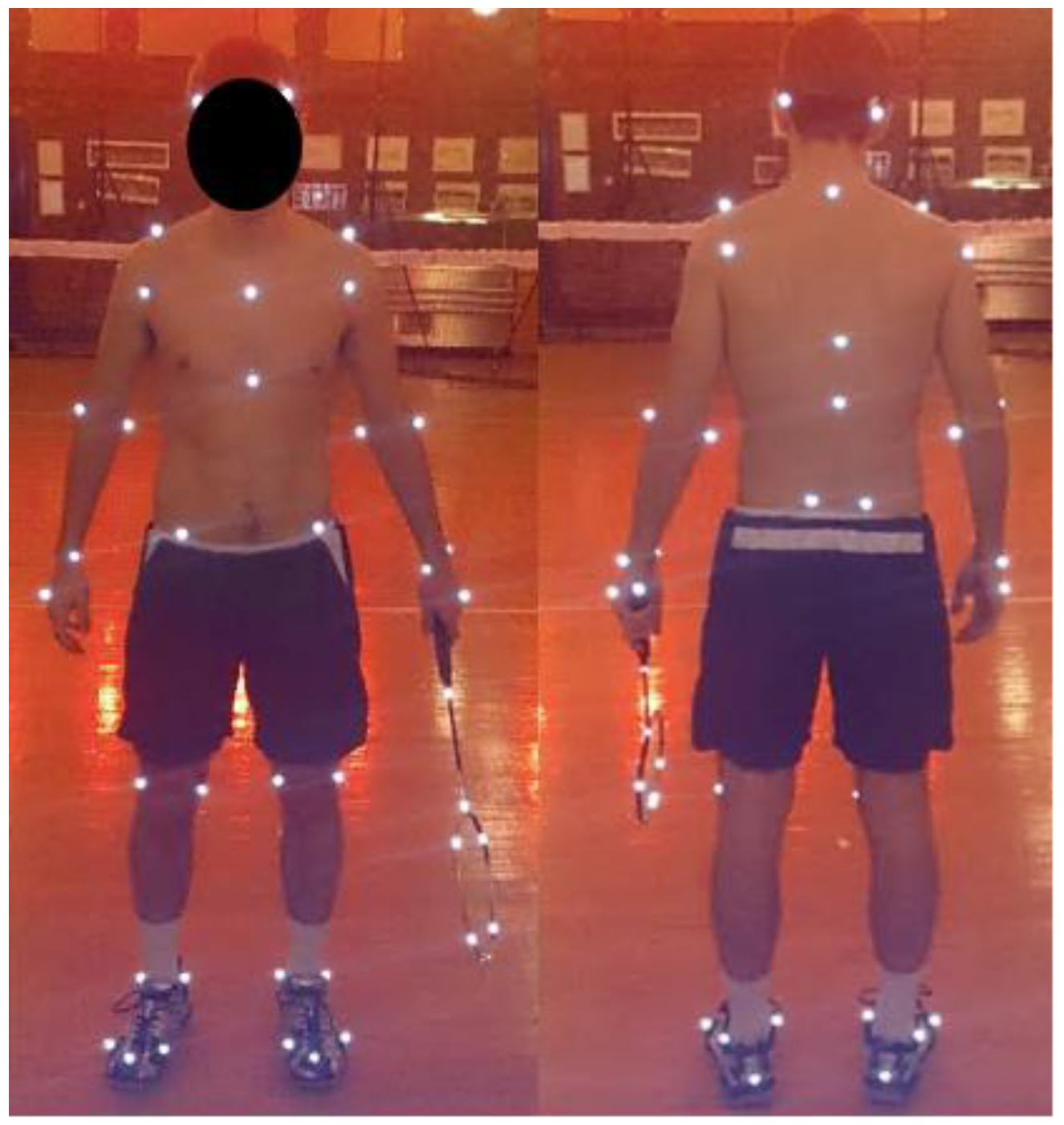
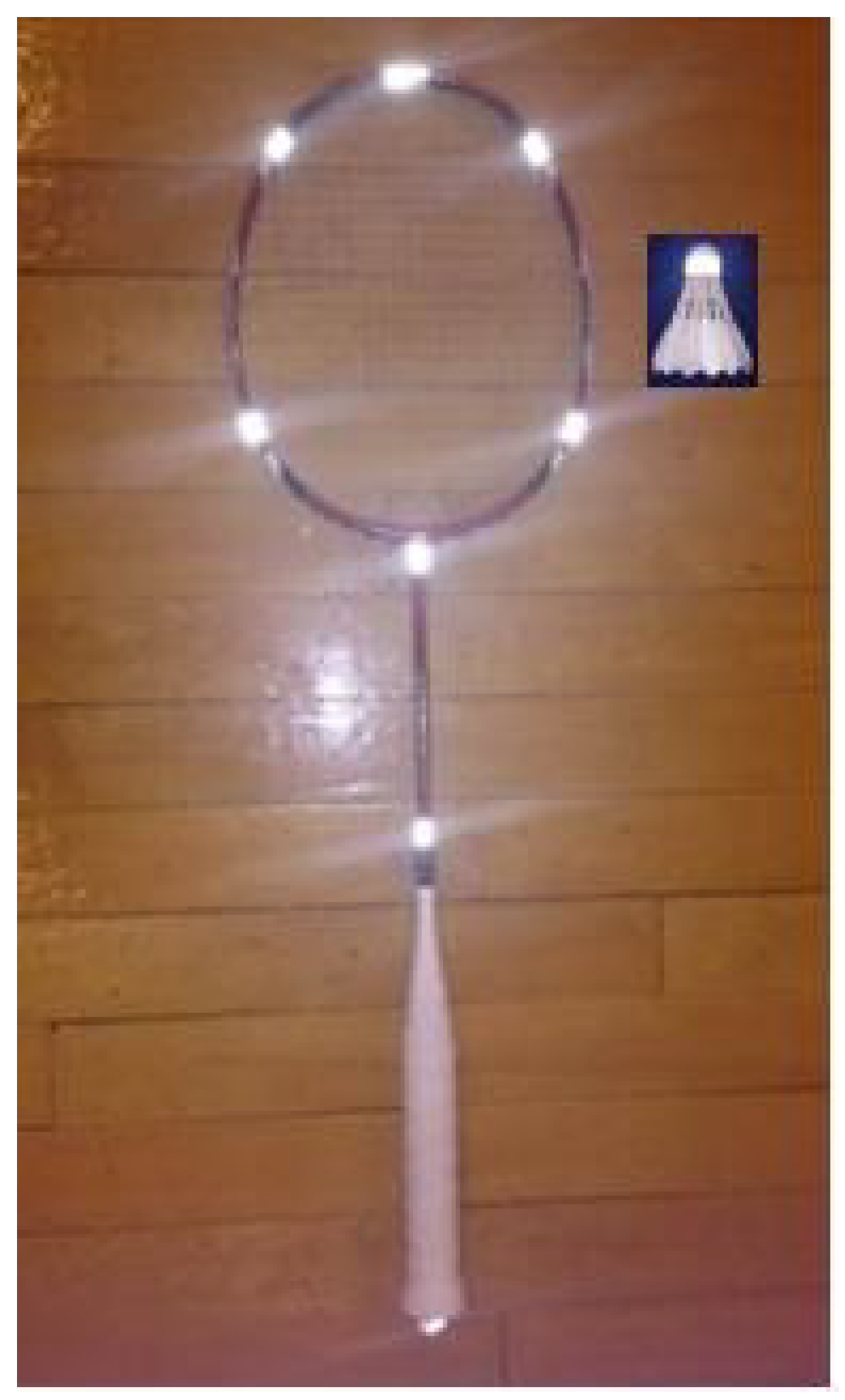
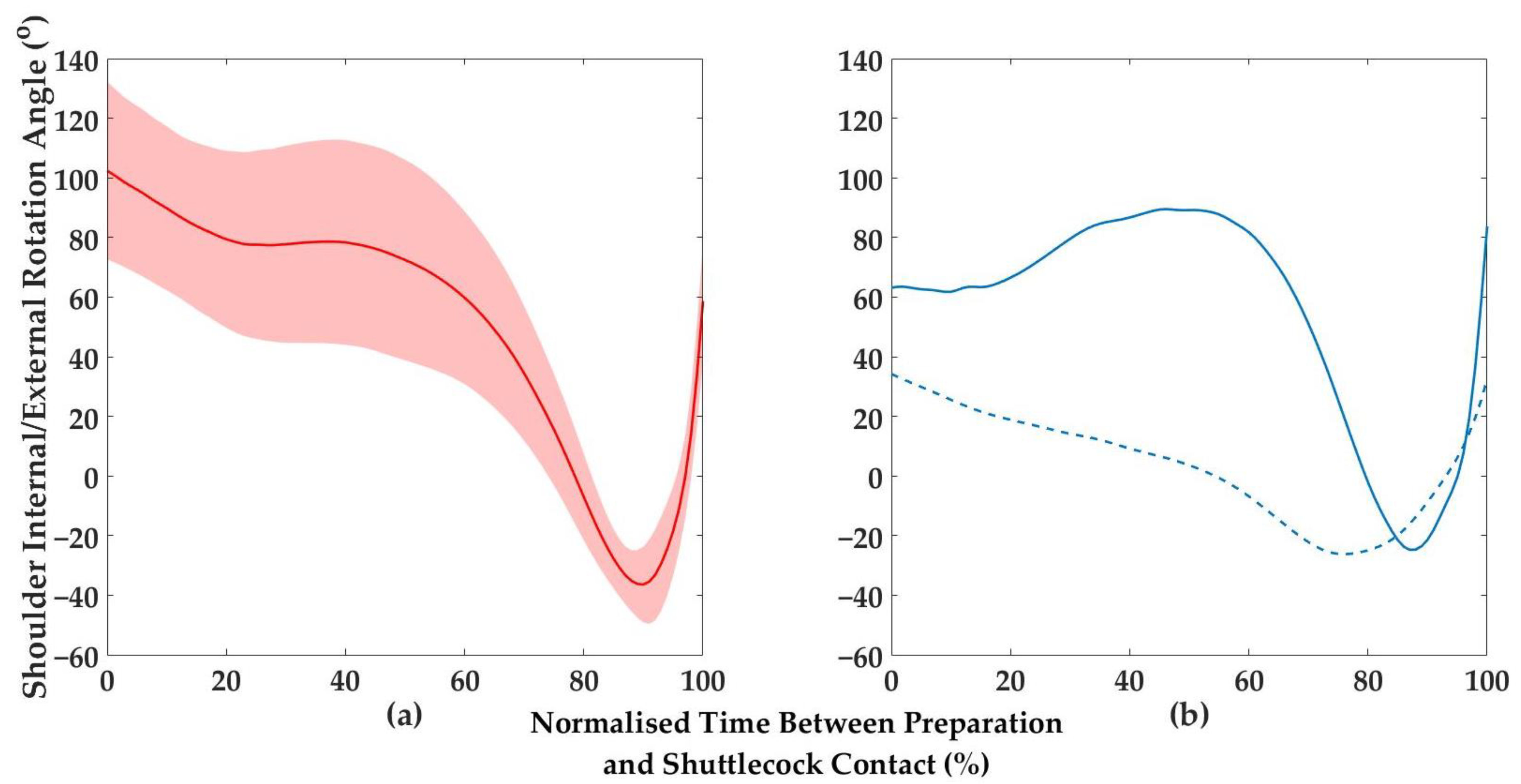
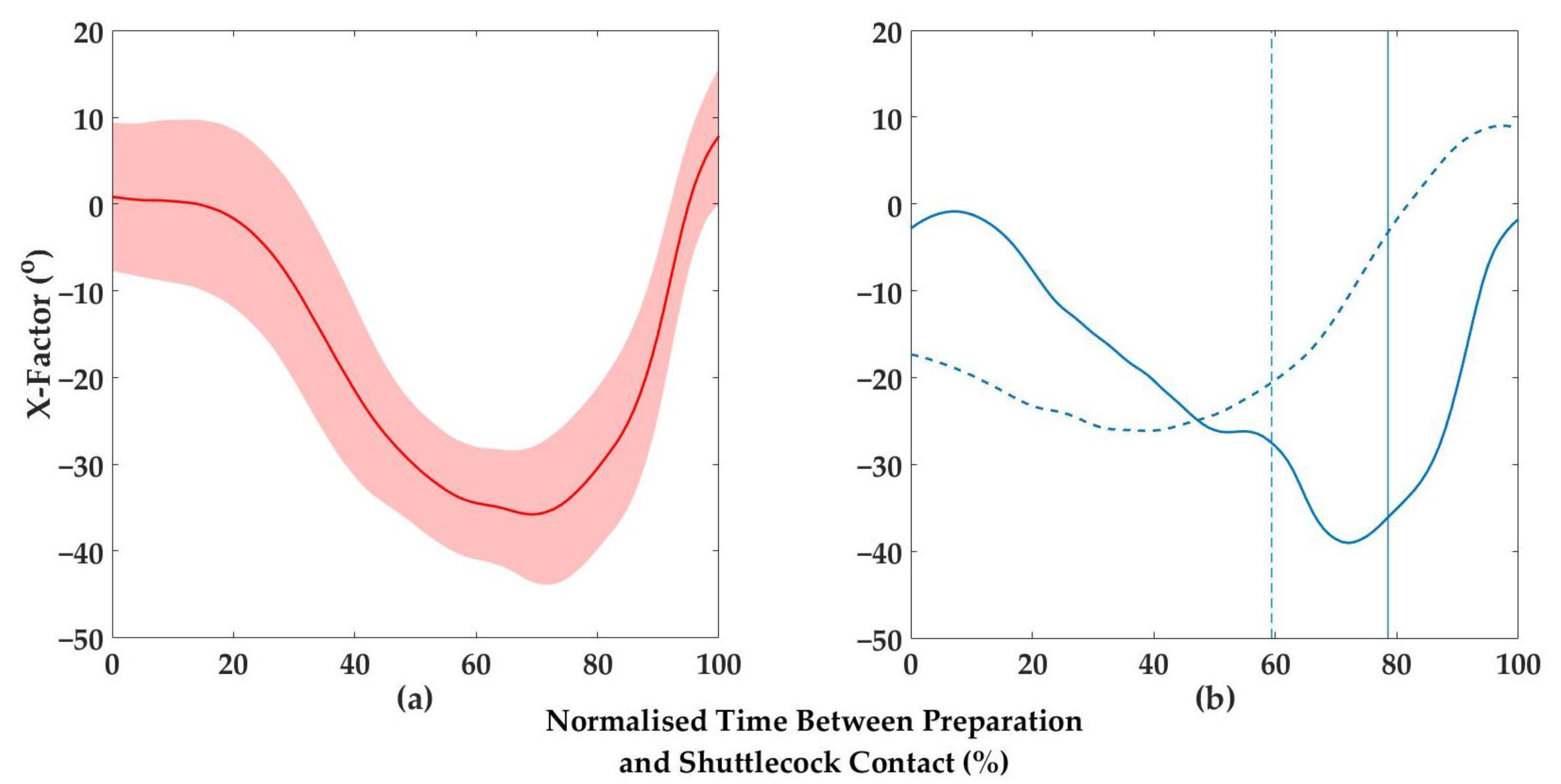
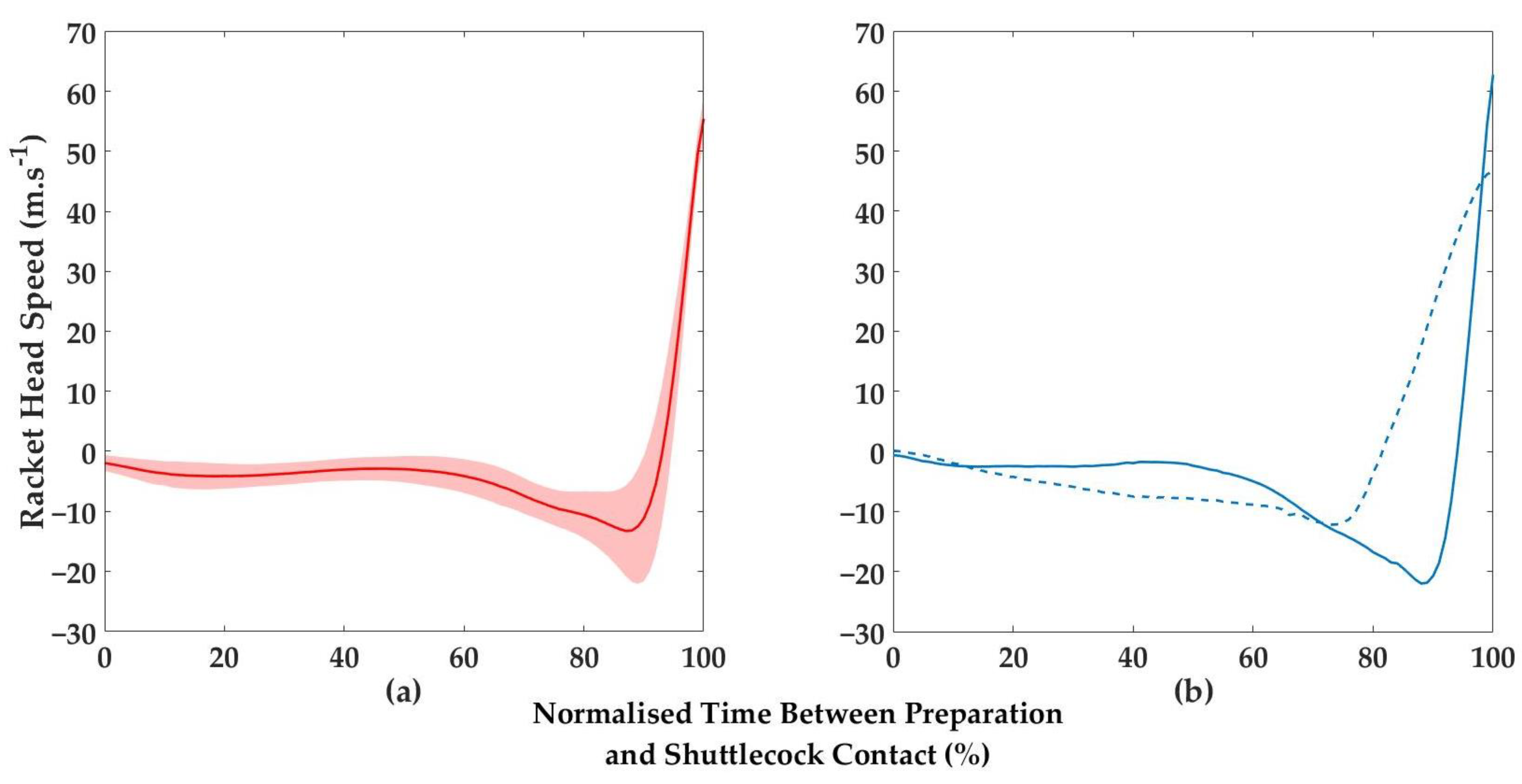
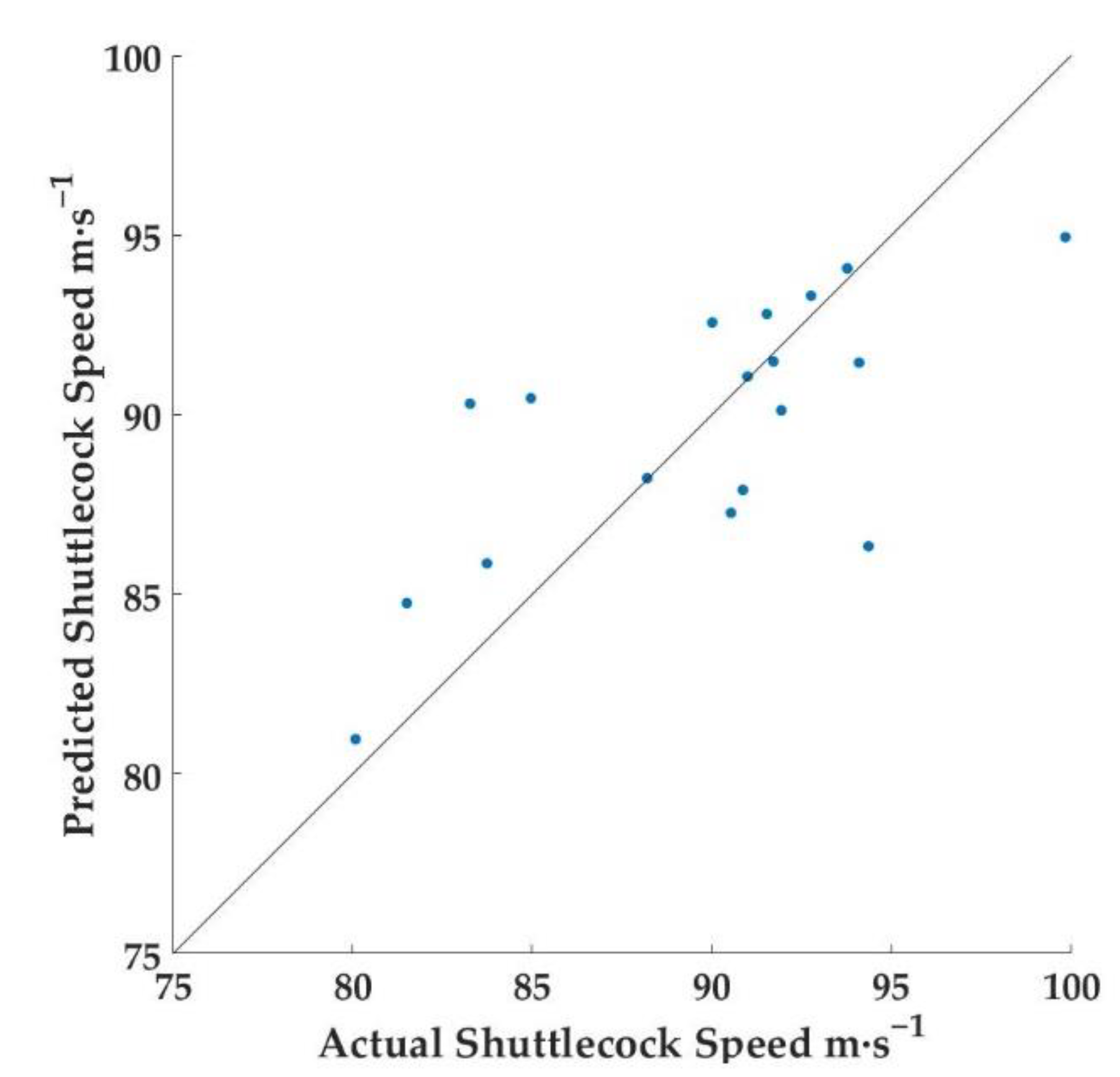
| Joint | Motion | Anatomical Position (°) | Positive Direction |
|---|---|---|---|
| Shoulder | Internal/External Rotation | † | Internal Rotation |
| Elbow | Flexion/Extension Pronation/Supination | 0 0 | Extension Supination |
| Wrist | Palmar Flexion/Extension Ulnar/Radial Deviation | 180 0 | Extension Ulnar Deviation |
| Trunk | X-Factor (Transverse Plane) | 0 | ‡ |
| Kinematic Variable | Key Instant/Phase | Mean (SD) | r | 95% CI | p |
|---|---|---|---|---|---|
| Racket Head Speed (m·s−1) | SC | 56.3 (4.0) | 0.903 | 0.753, 0.964 | <0.001 * |
| Jump Height (cm) | 31.6 (9.2) | 0.454 | −0.017, 0.760 | 0.059 | |
| Phase duration (ms) | BSP | 509.0 (94.8) | 0.412 | −0.067, 0.737 | 0.089 |
| AP | 38.1 (5.2) | −0.543 | −0.805, −0.101 | 0.020 * | |
| TS | 547.1 (92.5) | 0.392 | −0.092, 0.726 | 0.108 | |
| Peak Shoulder JC LV (m·s−1) | 3.5 (0.4) | 0.177 | −0.316, 0.595 | 0.482 | |
| Peak Elbow JC LV (m·s−1) | 8.3 (0.8) | 0.353 | −0.136, 0.704 | 0.151 | |
| Peak Wrist JC LV (m·s−1) | 14.2 (1.7) | 0.767 | 0.467, 0.908 | <0.001 * | |
| Shoulder IR ROM (°) | Peak−SC | 98.1 (20.7) | 0.403 | −0.079, 0.732 | 0.097 |
| Elbow Flexion ROM (°) | Peak−SC | 106.0 (7.9) | 0.016 | −0.454, 0.479 | 0.950 |
| Elbow PRO ROM (°) | Peak−SC | 21.2 (14.9) | 0.298 | −0.197, 0.671 | 0.230 |
| Wrist Flexion ROM (°) | Peak−SC | 40.4 (12.5) | −0.242 | −0.254, 0.637 | 0.333 |
| X−Factor ROM (°) | Peak−SC | 46.0 (9.4) | 0.208 | −0.287, 0.615 | 0.408 |
| Kinematic Variable | Key Instant/Phase | Mean (SD) | r | 95% CI (Lower, Upper) | p |
|---|---|---|---|---|---|
| Shoulder INT/EXT Rotation Angle (°) | P | 102.4 (29.8) | 0.324 | −0.168, 0.678 | 0.189 |
| ER | 1.9 (8.8) | 0.013 | −0.457, 0.477 | 0.959 | |
| RLP | −33.6 (8.2) | 0.161 | −0.331, 0.584 | 0.523 | |
| TP | −29.2 (13.7) | 0.299 | −0.195, 0.672 | 0.228 | |
| SC | 58.7 (20.0) | 0.508 | 0.054, 0.788 | 0.031 * | |
| Elbow Flexion Angle (°) | P | 88.4 (19.8) | 0.329 | −0.163, 0.690 | 0.183 |
| ER | 64.9 (8.0) | −0.206 | −0.614, 0.289 | 0.413 | |
| RLP | 74.2 (9.8) | 0.161 | −0.648, 0.236 | 0.298 | |
| TP | 120.6 (10.5) | 0.225 | −0.271, 0.626 | 0.370 | |
| SC | 166.1 (4.3) | 0.243 | −0.252, 0.638 | 0.331 | |
| Elbow Pronation Angle (°) | P | −61.6 (17.5) | 0.398 | −0.084, 0.730 | 0.102 |
| ER | −99.4 (20.0) | −0.180 | −0.597, 0.313 | 0.475 | |
| RLP | −84.0 (13.2) | 0.120 | −0.556, 0.368 | 0.636 | |
| TP | −95.4 (15.4) | −0.376 | −0.717, 0.111 | 0.125 | |
| SC | −101.5 (19.0) | −0.420 | −0.741, 0.059 | 0.083 |
| Kinematic Variable | Key Instant/Phase | Mean (SD) | r | 95% CI (Lower, Upper) | p |
|---|---|---|---|---|---|
| Wrist Flexion Angle (°) | P | 191.0 (13.0) | 0.368 | −0.120, 0.712 | 0.133 |
| ER | 208.2 (10.6) | −0.134 | −0.565, 0.356 | 0.598 | |
| RLP | 225.4 (9.9) | 0.146 | −0.344, 0.574 | 0.563 | |
| TP | 225.8 (9.3) | 0.021 | −0.451, 0.483 | 0.935 | |
| SC | 187.8 (8.9) | 0.190 | −0.304, 0.603 | 0.451 | |
| X−factor (°) | P | 0.8 (8.6) | 0.024 | −0.448, 0.485 | 0.926 |
| ER | −33.3 (5.8) | −0.484 | −0.775, −0.022 | 0.042 * | |
| RLP | −23.5 (7.1) | −0.362 | −0.709, 0.126 | 0.140 | |
| TP | −5.2 (7.6) | −0.175 | −0.593, 0.318 | 0.489 | |
| SC | 7.9 (7.9) | −0.077 | −0.525, 0.404 | 0.760 |
| Model | Kinematic Parameters | Coefficient | 95% CI | Variable, p | Model | |||
|---|---|---|---|---|---|---|---|---|
| Lower Bound | Upper Bound | Percent Explained | p | SEE | ||||
| a | (Constant) | 110.1 | 93.2 | 127.0 | <0.001 | 25.0 | 0.02 | 4.4 |
| AP Duration | −536.5 | −976.8 | −96.2 | 0.020 | ||||
| b | (Constant) | 95.8 | 76.7 | 114.9 | <0.001 | 43.7 | 0.05 | 3.8 |
| AP Length | −514.0 | −898.1 | −129.9 | 0.012 | ||||
| X−Factor at ER | −0.4 | −0.7 | −0.1 | 0.024 | ||||
© 2020 by the authors. Licensee MDPI, Basel, Switzerland. This article is an open access article distributed under the terms and conditions of the Creative Commons Attribution (CC BY) license (http://creativecommons.org/licenses/by/4.0/).
Share and Cite
King, M.; Towler, H.; Dillon, R.; McErlain-Naylor, S. A Correlational Analysis of Shuttlecock Speed Kinematic Determinants in the Badminton Jump Smash. Appl. Sci. 2020, 10, 1248. https://doi.org/10.3390/app10041248
King M, Towler H, Dillon R, McErlain-Naylor S. A Correlational Analysis of Shuttlecock Speed Kinematic Determinants in the Badminton Jump Smash. Applied Sciences. 2020; 10(4):1248. https://doi.org/10.3390/app10041248
Chicago/Turabian StyleKing, Mark, Harley Towler, Romanda Dillon, and Stuart McErlain-Naylor. 2020. "A Correlational Analysis of Shuttlecock Speed Kinematic Determinants in the Badminton Jump Smash" Applied Sciences 10, no. 4: 1248. https://doi.org/10.3390/app10041248






